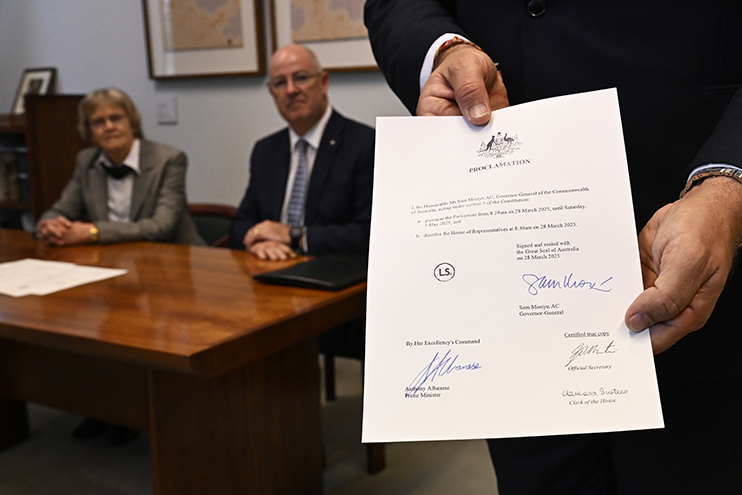Sessions of a parliament
The period of time between the first meeting of the House of Representatives following a general election and its expiry or dissolution (ending) for the next election is called ‘a Parliament’ and lasts for a maximum of three years. Each term of parliament is then divided into sessions.
The first session of a parliament starts on the first day that the parliament sits following a general election (see Infosheet No. 9 A new parliament) and ends when the parliament is prorogued or dissolved.
Prior to 1977, the number and duration of sessions in a term of parliament varied considerably. It is now the usual practice for parliaments to consist of only one session. The exception to this was the 44th Parliament, which had two sessions after being prorogued in 2016.
Proroguing the parliament
Prorogation is the process of formally closing a session of parliament. While prorogation ends a session of parliament, it does not end the parliament itself. Section 5 of the Constitution gives the Governor-General authority to prorogue the parliament. However, in practice the Governor-General follows the advice of the Prime Minister of the day.
Since 1906 all prorogations have been made by proclamation published in the Commonwealth Gazette. It is commonplace for the Official Secretary to the Governor-General to read the proclamation, usually accompanied by the Clerk and Deputy Clerk of the House and the Serjeant-at-Arms. Since 1977 proclamations have been read publicly at the front of Parliament House.
When a parliament is prorogued, all proceedings come to an end—that is, all business on the Notice Paper lapses (see Infosheet No. 12 Finding out about the House). In addition, the House does not sit, and certain committees no longer meet and transact business.
There is little constitutional guidance as to when or how often prorogation should take place. In recent times, prorogation has usually only occurred immediately prior to dissolution (see next section), meaning that the parliamentary term consists of only one session.

The Official Secretary to the Governor-General reading a proclamation to both prorogue the 46th parliament and dissolve the House of Representatives.
Prorogations not preceding the dissolution of parliament—recent examples
Since 1961, there have only been six prorogations that have not immediately preceded the dissolution of parliament. Specific circumstances applying at the time included:
-
the 1968 prorogation followed the death of Prime Minister Holt, which meant it was necessary to form a new ministry
-
parliament was prorogued in both 1974 and 1977 to enable the Queen to open new sessions of parliament when visiting Australia
-
the 2016 prorogation occurred on advice from the Prime Minister to the Governor-General, to enable the parliament to give full and timely consideration to important parcels of legislation. The second session ended when the Prime Minister advised the Governor-General to call a double dissolution (see Infosheet No. 18 Double Dissolution).
Table 1 (see p. 3) details the terms and sessions of Australian parliaments since 1901.
Dissolving the House of Representatives
The duration of a parliament is directly related to the duration of the House of Representatives. While a parliament can continue until the House of Representatives expires (three years from the date of its first meeting), it is more common for it to be dissolved by the Governor-General earlier than this.
Dissolution of the House terminates a parliament and triggers a general election.
The provisions of the Constitution means that it is the House that is regularly dissolved for electoral purposes, not the Senate (which is continuous in character except in the circumstances of a double dissolution). In practice, the Senate has never met after the House has been dissolved.
The Governor‑General’s authority to dissolve the parliament is set out in section 5 of the Constitution. By convention, the Governor‑General takes this action on the advice of the Prime Minister of the day.
Since 1993, the Governor-General has agreed to prorogue the parliament on the same day as the House is dissolved. Similar to prorogation, dissolution is effected by a proclamation published in the Commonwealth Gazette and usually read by the Official Secretary to the Governor‑General. In recent years, when the prorogation and dissolution have occurred on the same day, the Parliament has been prorogued and the House dissolved by a single proclamation.
After the proclamation has been read, the Clerk, Deputy Clerk and Serjeant-at-Arms return to the entrance to the House Chamber and the Clerk posts a copy of the proclamation at the door to the Chamber. An artillery salute may be fired at the precise time of dissolution to mark the end of the parliament.
The decision to dissolve a parliament carries more significance than the decision to prorogue a parliament. Upon dissolution of the House, all its proceedings come to an end. Further, members of the House cease to be members, sessional orders no longer have effect and committees cease to exist. Ministers continue in office and the Speaker continues to hold that position for administrative purposes, until a Speaker is elected in the next parliament.

The Clerk of the House of Representatives pinning the proclamation of dissolution for the 31st Parliament to the House of Representatives Chamber door.
Double dissolution
When there is continued disagreement between the House and the Senate about a proposed law, the Governor-General has, in certain circumstances, the power to dissolve both Houses simultaneously (a ‘double dissolution’). For more information on double dissolutions, see Infosheet No. 18 Double Dissolution.
On the occasion of a simultaneous dissolution of both Houses, Senate Clerks and the Usher of the Black Rod have also attended the reading of the proclamation.
For more information
House of Representatives Practice, 7th edn, Department of the House of Representatives, Canberra, 2018,
pp. 226-35; 825-29.
About the House website: www.aph.gov.au/athnews.
X: @AboutTheHouse | Bluesky: @aboutthehouse.bsky.social |
Facebook: Aboutthehouseau | Instagram: @abouttheHouse
Images courtesy of AUSPIC and the Department of the House of Representatives.